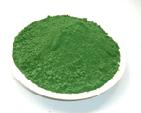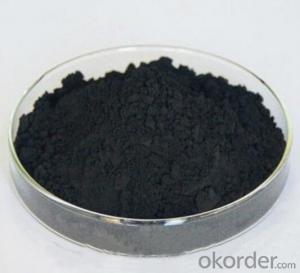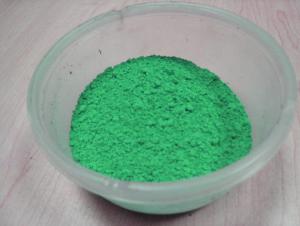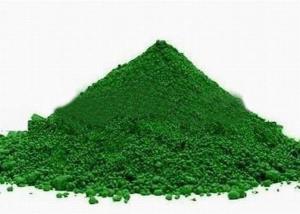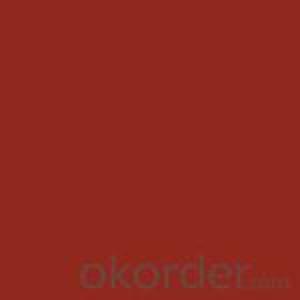Inorganic Green Pigments Chrome Oxide Green Abrasive Grade
- Loading Port:
- China Main Port
- Payment Terms:
- TT or LC
- Min Order Qty:
- 1 Metric Ton m.t.
- Supply Capability:
- 8000MT Per Year m.t./month
OKorder Service Pledge
OKorder Financial Service
You Might Also Like
Production Details Of Chrome Oxide Green :
1. Product Name: Chrome Oxide Green
2. Molecular Formula: Cr2O3
3. HS Code: 2819900000
4. CAS No. : 1308-38-9
5. Appearance: green powder
6. Specifications: (Quality Standard: HG/T 2775-1996)
Packing Details Of Chrome Oxide Green :
25 kg/ pp bag , or kraft bag or as your requirements .
Usage Of Chrome Oxide Green Powder :
Mainly used in paint, glass, ceramics, building materials colorants, printing ink, metal polishing, smelting metal chromium, fire-proof material, etc.
TDS of Chrome Oxide Green
Grade | OXA-0 | OXA-1 | OXA-2 |
Appearance | Green Power | ||
Cr2O3/% ≥ | 99 | 99 | 98 |
Moisture/% ≤ | 0.15 | 0.15 | 0.15 |
Water Soluble/% ≤ | 0.2 | 0.2 | 0.5 |
Polishing Force/[mg/(min.cm2)] ≥ | 0.2 | 0.1 | 0.3 |
Polished Surface Roughness/μm ≤ | 0.100 | 0.20 | 0.80 |
Note: At present in China, the abrasive standard without grinding performance standards, which cannot be grinding and polishing performance evaluation. But according to your needs or our experience to agreed.



- Q: A.catalyzes chemical reactions.B.absorbs light.C.transports materials.D nverts energy to light.E s energy.
- pigment is the coloring of your skin and considering your skin gets darker under sunlight im going to say it absorbs light.
- Q: are photosynthetic pigments separated based on their polarity or based on their molecular structure?Thanks
- Molecular structure... Chlorophylls are greenish pigments which contain a porphyrin ring. This is a stable ring-shaped molecule around which electrons are free to migrate. There are several kinds of chlorophyll, the most important being chlorophyll a. This is the molecule which makes photosynthesis possible, by passing its energized electrons on to molecules which will manufacture sugars. All plants, algae, and cyanobacteria which photosynthesize contain chlorophyll a. A second kind of chlorophyll is chlorophyll b, which occurs only in green algae and in the plants. A third form of chlorophyll which is common is (not surprisingly) called chlorophyll c, and is found only in the photosynthetic members of the Chromista as well as the dinoflagellates. The differences between the chlorophylls of these major groups was one of the first clues that they were not as closely related as previously thought. Carotenoids are usually red, orange, or yellow pigments, and include the familiar compound carotene, which gives carrots their color. These compounds are composed of two small six-carbon rings connected by a chain of carbon atoms. As a result, they do not dissolve in water, and must be attached to membranes within the cell. Carotenoids cannot transfer sunlight energy directly to the photosynthetic pathway, but must pass their absorbed energy to chlorophyll. For this reason, they are called accessory pigments. One very visible accessory pigment is fucoxanthin the brown pigment which colors kelps and other brown algae as well as the diatoms.
- Q: I have been looking over the internet and have yet to find the details I need. Such as the function and development of Pigments.
- The most important characteristics of pigments are: 1. They impart a colour to the medium to which they are applied. Remember that you can get white pigments, titanium dioxide, and black pigments, carbon black is typical. The pigments impart a colour merely by their presence , they are mostly chemically inert.They need some binder to fix them to the substrate. 3.They are insoluble in the carrier in which they are processed. 4. Pigments can be inorganic or organic, but the majority have a metal in their structure. 5. Pigments can occur naturally, but synthetically produced pigments to precise standards are by far the most used in industry. 4. In contrast to this, colourants that dissolve in the medium in which they are processed are called dyes or dyestuffs. 5.Dyes are by and large purely organic in structure, and do not contain metals in their chemical formulation. 6. Dyes undergo a chemical reaction with the substrate which they colour. 7. There is also a third type of product called an extender or filler. In the surface coating industry clays, calcium carbonate, etc fill this role. They do not add any colour to the paint, they become transparent in the paint binder medium, because of their low refractive index. They add body to the paint.
- Q: (After the fifteenth century)
- Pigment is color in powder form. An example is lamp black; it was first made from the soot of kerosene lamps ground fine. Binder is a substance used to hold pigment together and make it adhere; in the previous example, linseed oil would be the binder for the lamp black pigment. Vehicle is a medium acting as a solvent, carrier, or binder for paint; turpentine or mineral spirits would be a vehicle but so would linseed oil as well to help dilute the paint and help it cover a large area. Hope that helps and thanx.
- Q: a. chlorophyll ab. chlorophyll bc. chlorophyll cd. carotenoid pigments
- Chlorophylls are greenish pigments which contain a porphyrin ring. This is a stable ring-shaped molecule around which electrons are free to migrate. Because the electrons move freely, the ring has the potential to gain or lose electrons easily, and thus the potential to provide energized electrons to other molecules. This is the fundamental process by which chlorophyll captures the energy of sunlight. There are several kinds of chlorophyll, the most important being chlorophyll a. This is the molecule which makes photosynthesis possible, by passing its energized electrons on to molecules which will manufacture sugars. All plants, algae, and cyanobacteria which photosynthesize contain chlorophyll a. A second kind of chlorophyll is chlorophyll b, which occurs only in green algae and in the plants. A third form of chlorophyll which is common is (not surprisingly) called chlorophyll c, and is found only in the photosynthetic members of the Chromista as well as the dinoflagellates. The differences between the chlorophylls of these major groups was one of the first clues that they were not as closely related as previously thought. Carotenoids are usually red, orange, or yellow pigments, and include the familiar compound carotene, which gives carrots their color. These compounds are composed of two small six-carbon rings connected by a chain of carbon atoms. As a result, they do not dissolve in water, and must be attached to membranes within the cell. Carotenoids cannot transfer sunlight energy directly to the photosynthetic pathway, but must pass their absorbed energy to chlorophyll. For this reason, they are called accessory pigments. One very visible accessory pigment is fucoxanthin the brown pigment which colors kelps and other brown algae as well as the diatoms. From this I would say the answer is c.
- Q: Can somebody answer this in AP BIO language please
- A pigment molecule absorbs at specific wavelength(s), meaning that when light of a specific wavelength is incident to the molecule only certain wavelengths are absorbed while others are transmitted. The spectrophotometer emits monochromatic light (light of only one wavelength) which passes through the pigment molecule and a detector determines the amount of light that is either absorbed or transmitted by the sample. This is done at wavelengths from the UV (180-330 nm) to the visible (330-700 nm) and the light that is either transmitted or absorbed is detected by the spectrophotometer and is able to be graphed with absorbance representing the y-axis and wavelength representing the x-axis. The resultant graph will depict the absorption spectrum of that particular pigment molecule. Hope that helps.
- Q: how exactly do pigments work? i know that they absorb every color except the one that we see, but what are the exact physics or whatever behind the selective absorption of the light?
- Photons are the packets of energy that light delivers. Different colors of light have different amounts of energy in each of the light's photons. So, green light's photons have different amounts of energy from red light's photons. Different materials absorb different amounts of energy via photons very selectively. It has to do with the energy states of the molecules, and the electrons that are in the outer shell.
- Q: How can you extract pure pigments from a sample of leaves in a form that you could test the absorbency of the various pigments??I don't know how to extract enough pigment in order to fill a cuvette and measure the absorbance, please help!! :D
- Separation of plant pigments using chromatography. Paper chromatography is a useful technique in the separation and identification of different plant pigments. In this technique, the mixture containing the pigments to be separated is first applied as a spot or a line to the paper about 1.5 cm from the bottom edge of the paper. The paper is then placed in a container with the tip of the paper touching the solvent. Solvent is absorbed by the chromatographic paper and moved up the paper by capillary action. As the solvent crosses the area containing plant pigment extract, the pigments dissolve in and move with the solvent. The solvent carries the dissolved pigments as it moves up the paper. The pigments are carried along at different rates because they are not equally soluble. Therefore, the less soluble pigments will move slower up the paper than the more soluble pigments. This is known as developing a chromatogram.
- Q: what is the function of pigment molecules in photosynthesis?
- They absorb light from the sun
- Q: the absorption spectrum and the range of light reflected by each
- A okorder /... gives the spectra (Action and Absorption)
1. Manufacturer Overview
| Location | Liaoning, China |
| Year Established | 1960 |
| Annual Output Value | Above US$ 100 Million |
| Main Markets | 20.00% North America 20.00% South Asia 10.00% Middle East 10.00% North America 10.00% Northern Europe 10.00% South Asia 10.00% Western Europe 5.00% Africa 5.00% Eastern Europe |
| Company Certifications | ISO9001:2000 |
2. Manufacturer Certificates
| a) Certification Name | |
| Range | |
| Reference | |
| Validity Period |
3. Manufacturer Capability
| a) Trade Capacity | |
| Nearest Port | Dalian Port |
| Export Percentage | 41% - 50% |
| No.of Employees in Trade Department | 10-20 People |
| Language Spoken: | English; Chinese; |
| b) Factory Information | |
| Factory Size: | Above 10,000 square meters |
| No. of Production Lines | Above 6 |
| Contract Manufacturing | design and manufacture service offered. |
| Product Price Range | High; Average |
Send your message to us
Inorganic Green Pigments Chrome Oxide Green Abrasive Grade
- Loading Port:
- China Main Port
- Payment Terms:
- TT or LC
- Min Order Qty:
- 1 Metric Ton m.t.
- Supply Capability:
- 8000MT Per Year m.t./month
OKorder Service Pledge
OKorder Financial Service
Similar products
Hot products
Hot Searches
Related keywords




